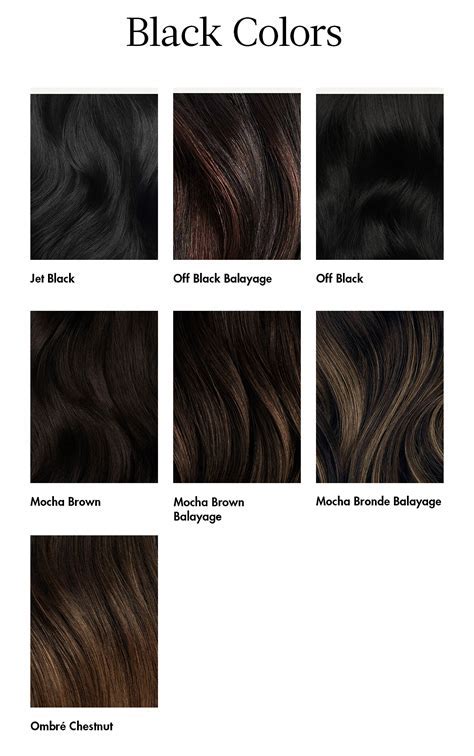Introduction:
Black women’s hair is a versatile and beautiful canvas that holds unique cultural significance. Its intricate textures and diverse hues offer endless possibilities for self-expression. This comprehensive guide delves into the complexities of black hair color, providing expert insights and practical steps to achieve your desired shade while maintaining its health and vitality.

Understanding Your Natural Hair Color
1. The Fitzpatrick Scale: Classifying Skin Tones
The Fitzpatrick scale categorizes skin tones into six types, ranging from fair (Type I) to deeply pigmented (Type VI). Black women typically fall within Types IV to VI, known for their high melanin content, which contributes to their hair’s natural darkness.
2. Melanin: The Pigment That Gives Hair Its Color
Melanin is a pigment found in hair, skin, and eyes. It exists in two forms: eumelanin (black-brown) and pheomelanin (red-yellow). Black hair owes its dark color to a high concentration of eumelanin.
The Art of Coloring Black Hair
1. Dyeing and Bleaching: Transforming Your Shade
Dyeing adds color to hair by penetrating the cuticle and depositing pigments. Bleaching removes color from hair by lightening eumelanin, allowing other colors or dyes to be applied.
2. Semi-Permanent and Permanent Dyes: Know the Difference
Semi-permanent dyes deposit color on the hair’s surface and last for 4-6 weeks. Permanent dyes penetrate the cuticle and contain ammonia, which helps lift cuticular scales for deeper color penetration.
3. Temporary Color: Instant Gratification
Temporary color, such as hair chalk or spray-on dyes, provides a quick and easy way to experiment with different shades without chemically altering your hair.
Choosing the Right Shade for You
1. Consider Your Skin Tone
The best hair color for you will complement your skin tone. For warmer skin tones, warm shades like copper or reddish-brown are flattering. Cool skin tones suit cooler shades like blue-black or ash-brown.
2. Assess Your Hair Texture
Different hair textures require different care and color treatments. Fine hair may need more pigment to achieve a noticeable change, while thick hair may require multiple applications.
3. Think About Your Style
Consider your desired hairstyle and lifestyle when choosing a color. Bright colors or highlights may require more frequent touch-ups, while natural shades offer lower maintenance.
Healthy Coloring Practices
1. Protect Your Hair from Damage
Before coloring, use a protein treatment to strengthen hair and prevent breakage. Avoid using harsh chemicals or bleaching too frequently.
2. Use Color-Protecting Products
Color-protecting shampoos and conditioners help maintain the vibrancy of your color and reduce fading.
3. Moisturize Regularly
Colored hair tends to be drier, so regular moisturizing is essential to keep it soft and manageable. Use deep conditioners and leave-in treatments formulated for color-treated hair.
Common Mistakes to Avoid
1. Not Doing a Strand Test
Always perform a strand test on a small section of hair before applying color to the entire head. This will help you determine the processing time and avoid unexpected results.
2. Overlapping Color Applications
Applying color over previously colored hair can result in uneven absorption and blotchy results. Allow color to fade out before recoloring.
3. Using Box Dye on Bleached Hair
Bleached hair is more porous and can easily become damaged by box dyes. Opt for professional coloring if your hair has been chemically lightened.
Step-by-Step Approach
1. Gather Your Materials
You will need: hair dye, developer, mixing bowl, gloves, brush, and a wide-tooth comb.
2. Prepare Your Hair
Wash your hair with clarifying shampoo to remove any product buildup. Towel-dry and comb to remove tangles.
3. Mix the Color
Combine the hair dye and developer in the mixing bowl according to the manufacturer’s instructions. Stir thoroughly until you achieve a smooth and creamy consistency.
4. Apply the Color
Use the brush to apply the color evenly to your hair, starting from the roots and working towards the ends. Avoid getting color on your skin or scalp.
5. Process the Color
Cover your hair with a plastic cap and process the color for the amount of time specified in the instructions.
6. Rinse and Style
Rinse your hair with cool water until the water runs clear. Shampoo and condition with color-safe products. Style as desired.
Conclusion
Black women’s hair is a canvas of limitless possibilities. By understanding your natural hair color, choosing the right shade, and following healthy coloring practices, you can enhance your unique beauty and express yourself through the vibrant hues of your hair. Embrace the versatility of your locks and unlock the power of color to elevate your style and confidence.
